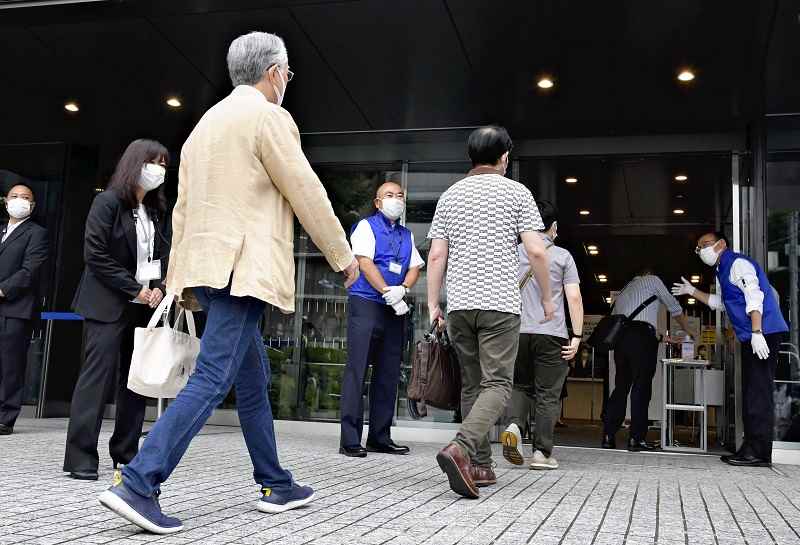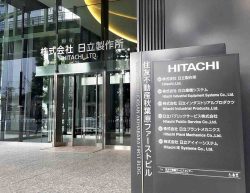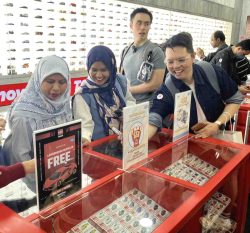
Shareholders of Toshiba Corp. enter the venue for the company’s annual general shareholders’ meeting in Shinjuku Ward, Tokyo, on June 25.
14:53 JST, July 14, 2021
The rejection of the proposed reappointment of Toshiba Corp.’s chair of the board at the company’s annual general shareholders’ meeting on June 25 was an unusual event. The company had originally nominated 13 candidates for its board of directors, but now only eight names remain on the list.
Toshiba is a prestigious, time-tested company, which has produced such prominent businesspeople as Taizo Ishizaka and Toshio Doko, both of whom served as the chair of the Japan Federation of Economic Organizations.
The Yomiuri Shimbun has delved into what is happening at the company and its underlying background by gathering insights from those involved.
Foreshadowing
Osamu Nagayama, 74, the rejected chair of the board, is not an obscure businessman.
His father, Tokio Nagayama, served as the first deputy vice minister of the International Trade and Industry Ministry (the current Economy, Trade and Industry Ministry) and chairman of Showa Shell Sekiyu K.K. as well.
Osamu Nagayama himself worked for the Long-Term Credit Bank of Japan (now Shinsei Bank) and then joined Chugai Pharmaceutical Co., where he served as president and then chairman. From 2013 to 2019, he chaired the board of directors of Sony Corp. (now Sony Group Corp.).
In July 2020, Nagayama became an outside director of Toshiba. He also took the posts of chair of the board of directors and chair of the nomination committee responsible for leading the selection of top executives.
In April this year, the British investment fund CVC Capital Partners proposed acquiring all of Toshiba’s shares and then delisting them. Nagayama dismissed the proposal.
Nagayama said to people close to him, “As the company just returned to the First Section of the Tokyo Stock Exchange, it does not have such an idea. Nobody wants to listen [to the proposal’s details].”
Although he was not against the possibilities of the board discussing the matter if a detailed proposal was received, it appeared to people outside the company that he stuck to having the company remain listed. His way of handling the situation at that time resulted in negative consequences for him.
External report
Before CVC’s proposal surfaced, Toshiba’s share price was hovering at around ¥3,900 per share. The acquisition price suggested by CVC was ¥5,000 per share. For the investment funds that owned Toshiba shares, CVC’s proposal was a golden opportunity to secure profits.
That opportunity vanished, as CVC essentially withdrew its proposal. The investment funds involved, which thought the opportunity was “ruined by Nagayama,” waited for their next chance.
One of the investment funds, Effissimo Capital Management, expressed its wishes on June 10, only two weeks before the shareholders’ meeting. Three lawyers appointed by the investment fund, which is Toshiba’s largest shareholder and known as an “activist shareholder,” visited the company’s headquarters to present a report about 120 pages long.
The report asserts that Toshiba’s management, in cooperation with the trade ministry, attempted to prevent shareholders from exercising their rights at the shareholders’ meeting held in July last year. The report argues that the meeting was not organized fairly. Although differing opinions were presented by some government officials, they were dismissed.
People involved with Toshiba were distressed about the matter. One executive said: “There is no guideline that defines the relational distance between us and the trade ministry. It is difficult to prevent similar things from happening again.”
Toshiba held a board meeting on June 13 and decided to remove two candidates for director positions: Junji Ota, 73, chair of the audit committee, and Takashi Yamauchi, 70, one of the two members of the committee. The reasoning was that they had been aware of the actions of the company leadership and the ministry but had not taken any measures.
Nobuyuki Kobayashi, 71, the other audit committee member, was kept on the list of candidates because Nagayama determined that the board needed Kobayashi’s certified public accountant license.
If the board had decided to have Kobayashi retire as well, the situation would not have gone so badly. As Nagayama also chaired the nomination committee, leading the selection of top executives, the difference in the treatment of audit committee members became an easy target for criticism.
Advisory firm’s report
On June 14, the day after the board meeting, a report was released that threw Toshiba into turmoil.
An influential U.S. voting advisory firm, Institutional Shareholder Services Inc. (ISS), recommended that Toshiba’s shareholders vote against the reappointments of Nagayama and Kobayashi.
In general, institutional investors, such as pension funds and insurance companies, can exercise their voting rights based on this kind of report.
One such investment fund said, “We need to have a reason if our voting does not follow the recommendations of advisory firms.”
A source at Toshiba revealed: “Immediately after the report was released, the votes against Nagayama’s reappointment began to increase suddenly.”
On June 21, Toshiba released an internal investigation report stating that there had been no unreasonable interference with shareholders. But it was not able to change the trend.
Delicate power balance
More than half of the votes were against Nagayama.
On the evening of June 24, the day before the shareholders’ meeting, there was a gloomy atmosphere in the Toshiba headquarters.
The tally of voting rights exercised in advance by postal mail and online was clearly leaning toward the rejection of Nagayama’s reappointment.
“It’s a tough situation,” Nagayama murmured.
“At that time, he was calm, probably because he anticipated the outcome,” a source said.
At the shareholders’ meeting on June 25, the reappointments of Nagayama and Kobayashi were rejected.
About 44% of the votes were cast for Nagayama and only about 25% for Kobayashi.
Of the nine elected directors, George Olcott, 66, who had become an outside director at the request of Nagayama and others, resigned on the day because Nagayama would retire.
Of the eight remaining directors, only two had been with Toshiba for many years as employees: President Satoshi Tsunakawa, 65, and Vice President Mamoru Hatazawa, 62.
Of the outside directors, four are non-Japanese, all appointed in 2019 at the behest of investment funds. The Japanese and foreign nationals on the board are currently equal in number, indicating a tense power balance.
Next shareholders’ meeting
Toshiba plans to hold an extraordinary shareholders’ meeting this fall at the earliest to once again propose the election of board members. The company is hurrying to choose a chair of the board, who is needed to lead board discussions.
After the shareholders’ meeting in June, some of the retiring directors held a luncheon.
When talking in a low voice about new board members, one of them said, “Who would want to come to a company that ousted capable people from outside only one year or so after asking them to work for it?” The other participants nodded.
As president, Tsunakawa will serve also as chair of the board for the time being. But he is regarded as a stopgap even by people around him. There is a strong view that his involvement is only a temporary step until the next president is appointed.
Regarding the extraordinary general meeting, it is certain that the investment funds holding Toshiba shares will interfere in the selection of board members to increase their involvement in the company’s operation. Toshiba’s struggles with shareholders will go on.
"Business" POPULAR ARTICLE
-

Keidanren Chairman Yoshinobu Tsutsui Visits Kashiwazaki-Kariwa Nuclear Power Plant; Inspects New Emergency Safety System
-

Imports of Rare Earths from China Facing Delays, May Be Caused by Deterioration of Japan-China Relations
-

University of Tokyo Professor Discusses Japanese Economic Security in Interview Ahead of Forum
-

Japan Pulls out of Vietnam Nuclear Project, Complicating Hanoi’s Power Plans
-

Govt Aims to Expand NISA Program Lineup, Abolish Age Restriction
JN ACCESS RANKING
-

Keidanren Chairman Yoshinobu Tsutsui Visits Kashiwazaki-Kariwa Nuclear Power Plant; Inspects New Emergency Safety System
-

Imports of Rare Earths from China Facing Delays, May Be Caused by Deterioration of Japan-China Relations
-

University of Tokyo Professor Discusses Japanese Economic Security in Interview Ahead of Forum
-

Japan Pulls out of Vietnam Nuclear Project, Complicating Hanoi’s Power Plans
-

Govt Aims to Expand NISA Program Lineup, Abolish Age Restriction























